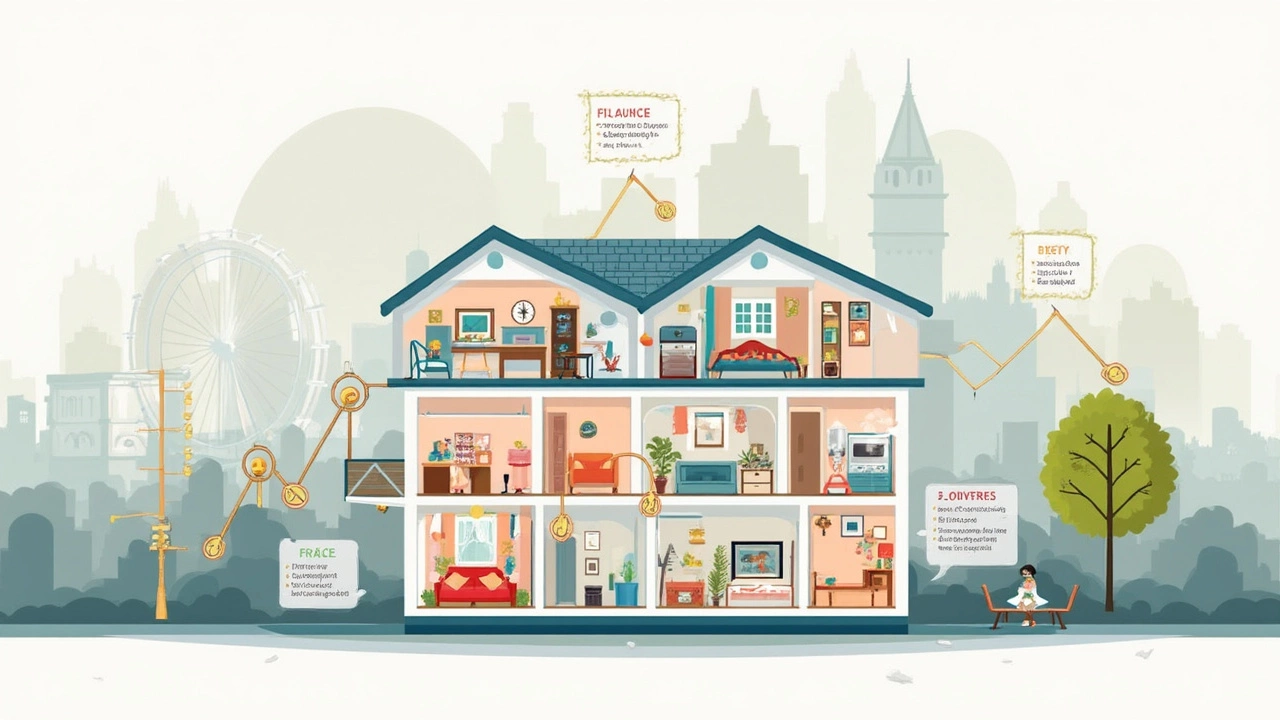Ever look at home prices online and wonder, "Is that even possible on my income?" You’re not alone. If your yearly paycheck is $70,000, figuring out what price range you should stick to is step one to avoid getting in over your head. But it's not just about tossing a number into a mortgage calculator. Lenders check everything, from your credit score to your debt, so knowing the full picture can keep you out of trouble.
The truth? Most people are surprised at what really matters. Hint: that online 'affordability' estimate often leaves out things like insurance, taxes, and closing fees. Forgetting to account for these can turn your monthly payment into a headache. Let’s drill down into what you really need to know for a smart, stress-free house hunt on a $70K salary.
- What Really Determines How Much You Can Afford
- Crunching the Numbers: Breaking Down $70,000
- Common Hidden Costs (and How to Prepare)
- Smart Moves for First-Time Buyers
What Really Determines How Much You Can Afford
If you’re thinking about buying a home on a $70,000 salary, you’ll want to know what banks and lenders actually look at before they approve your application. It’s more than just your income. Here’s what decides your price range:
- Debt-to-Income Ratio (DTI): Lenders care about how much of your monthly income goes to paying debts, like car payments, credit cards, or student loans. For most home loans, they want your total debts (including your future mortgage) to be under 43% of your pre-tax monthly income. If you make $70,000 a year (that’s about $5,833 a month before taxes), your maximum debt payments shouldn't top $2,508 a month.
- Down Payment: The cash you can put down upfront affects how much house you can buy. The bigger the down payment, the smaller your loan, and sometimes the better your mortgage rate. Most first-time buyers put down 3%–10%. So, for a $300,000 home, you’re looking at $9,000 to $30,000 down.
- Credit Score: The higher your credit score, the better your interest rate. Most lenders want at least a 620 to qualify for a basic loan, but higher is always better because even a 1% difference in rates can change your monthly payment by hundreds of bucks.
- Monthly Expenses: Lenders check insurance, property taxes, HOA fees, and whether you’ll pay mortgage insurance (PMI). These can add $300–$600 or more to your monthly bill.
Here’s a quick look at how these factors stack up if you’re making $70K a year:
| Factor | Impact on Affordability |
|---|---|
| Debt-to-Income Ratio | Limits max monthly payment you can afford, including all debts |
| Down Payment | Bigger down payment = more home buying power |
| Credit Score | Better score = lower interest rates, lower payments |
| Monthly Costs (taxes, insurance, etc.) | Adds to monthly expense, lowers price range you can target |
The bottom line: what you’re approved for isn’t always what you’re comfortable paying. Just because the bank says yes to a big loan doesn’t mean you should max things out. Make sure your lifestyle and future plans fit the home and payment you choose.
Crunching the Numbers: Breaking Down $70,000
Let’s get real about what your $70,000 salary means for buying a house. The first thing most lenders look at is your debt-to-income (DTI) ratio. They want your monthly debts—including the future mortgage payment—to be no more than about 36% of your gross (before tax) income. And most often, the mortgage part alone shouldn’t be over 28% of your gross monthly income.
So if you're making $70,000 a year, that’s about $5,833 a month before taxes. Here’s the math for the main limits lenders use:
- 28% (just your housing costs): $5,833 × 0.28 = $1,633 a month is the most banks want you paying for mortgage, taxes, and insurance combined.
- 36% (all debts, including car loans, credit cards, student loans): $5,833 × 0.36 = $2,100 a month.
If you have no other debt, you can aim higher within that window. But most people have at least something—maybe a car payment or student loans. That chips away at what you can use for a mortgage each month.
Still, what does that mean for actual home prices? With a 3% down payment (the lowest many first-timers go) and an average 30-year loan at today’s rate—let’s say 6.75%—here’s a rough idea of your budget:
| Down Payment | Home Price Range | Estimated Monthly Payment |
|---|---|---|
| 3% | $240,000 – $280,000 | $1,500 – $1,700 |
| 10% | $270,000 – $320,000 | $1,600 – $1,800 |
Remember, your mortgage payment isn’t just paying off the house—it includes stuff like property taxes, homeowners insurance, and maybe even mortgage insurance (PMI) if your down payment is under 20%. Also, if you’re in a place with high property taxes, the price range above will shrink.
To sum up: on $70,000 a year, you’re typically looking at homes in that $240K–$320K range if you keep debt low and shop for the best loan deal. Always run your own numbers and don’t just trust what an online calculator spits out—your spending, debts, and down payment really matter.

Common Hidden Costs (and How to Prepare)
It’s easy to focus just on the down payment and mortgage when you’re house hunting, but the price tag goes way beyond that. First-time buyers making $70,000 a year often get surprised by extra expenses that hit hard right around closing time—or even months later. Knowing these costs can help you plan smarter and avoid nasty surprises.
Here are some of the main culprits you’ll want to budget for alongside your mortgage:
- Property Taxes: These can range from a few hundred bucks a year to thousands, depending on your area. For example, in Texas, some counties have property taxes above 2% of a home’s value each year. That can be $4,000 or more annually for a $200,000 home.
- Homeowners Insurance: Lenders require it, and it typically costs between $1,000–$2,000 per year, depending on your home and location.
- Private Mortgage Insurance (PMI): If your down payment is less than 20%, expect to pay PMI. For many buyers, this can add $100–$200 a month until you’ve paid enough equity.
- Closing Costs: These include lender fees, appraisal, title insurance, and more. They usually add up to 2%–5% of your home’s value and are due upfront. On a $300,000 house, you might need $6,000–$15,000 just to close.
- HOA Fees: If your place has a Homeowners Association, fees can run from $100 to over $400 a month, depending on the neighborhood.
- Maintenance & Repairs: You’ll probably spend 1%–2% of your home’s price each year just keeping things running. That’s stuff like fixing the HVAC, lawn upkeep, or dealing with leaks.
Here’s what the first year of extra costs could look like on a $300,000 home:
| Expense | Typical Annual Estimate |
|---|---|
| Property Taxes | $4,500 |
| Homeowners Insurance | $1,500 |
| PMI | $1,800 |
| HOA Fees | $2,400 |
| Maintenance | $3,000 |
So, you could be on the hook for $13,000 or more outside your mortgage just in the first year.
Want to keep these costs from getting out of hand? Try these tips:
- Before shopping, ask your lender and agent for a full estimate of all monthly costs—not just principal and interest.
- Talk to locals or check online forums to get the real scoop on HOA fees and property taxes for the neighborhoods you like.
- Set aside an emergency fund. Aiming for 1% of the home’s price per year is smart, especially for older houses.
- Don’t forget to budget for things like moving expenses, new locks, and maybe even new appliances if yours aren’t included.
Covering these house affordability extras means you’ll feel a lot less financial pressure after moving in—and your first year as a homeowner won’t feel like a never-ending bill collector is knocking.
Smart Moves for First-Time Buyers
If you’re aiming to buy your first place on a $70,000 salary, a few smart choices can make the difference between stressing out over bills and settling in comfortably. Start by building up your credit score. Lenders take this score seriously—a score of 740 or higher could get you much better mortgage rates. A lower rate means lower payments every single month. If your score isn’t there yet, even a year of paying off a credit card or keeping balances low can help.
Don’t let the down payment trip you up. While 20% down is classic advice, several loan programs let you buy with less—sometimes just 3% down. But remember, putting less down can mean paying private mortgage insurance (PMI) until you reach 20% equity. That’s a monthly add-on, so factor it into your house affordability math.
- Shop around for lenders. Rates and closing costs can vary more than you think from one bank to the next.
- Use a mortgage advisor or talk to your local credit union—sometimes they offer deals big banks can’t match.
- Budget for the full monthly payment, not just the mortgage. Property taxes, homeowners insurance, and sometimes association dues all add up.
- Leave some cushion in your emergency fund. When you own a home, unexpected repairs are your problem. Aim for at least three months of living expenses saved up.
Here’s a quick look at what some extra costs can add to your payment, based on actual averages as of early 2025:
| Cost Type | National Monthly Average |
|---|---|
| Property Taxes | $280 |
| Homeowners Insurance | $140 |
| PMI (if less than 20% down) | $90 |
| HOA Fees (if applicable) | $250 |
Another smart move? Get pre-approved before you even tour homes. Sellers take you more seriously and you’ll know your real price limit upfront. And don’t skip reading the fine print on offers, contingencies, and inspection rights. Rushed decisions or skipping the home inspection can cost you big if hidden problems pop up later.
Bargain for repairs or closing costs—the worst they can do is say no. And above all, don’t stretch yourself to your final dollar just because you qualify for a big loan. The monthly squeeze isn’t worth it. Staying under budget feels boring now, but you’ll thank yourself when life throws a curveball.


Corbin Fairweather
I am an expert in real estate focusing on property sales and rentals. I enjoy writing about the latest trends in the real estate market and sharing insights on how to make successful property investments. My passion lies in helping clients find their dream homes and navigating the complexities of real estate transactions. In my free time, I enjoy hiking and capturing the beauty of landscapes through photography.
view all postsWrite a comment